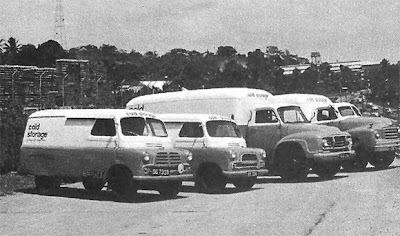In my dad's car, we would look out at the landmarks passing by; and of all those I can recall, one stood out because it meant we were nearing home.
As the car climbed and crested the hill at the 8th mile Bukit Timah Road, we would see a big building with the words H-U-M-E surrounded by large circular pipes.
Located just beside the Ford Factory, Hume was the largest factory complex located within the Hillview Industrial Estate. It occupied a sprawling area stretching more than a kilometre along Upper Bukit Timah Road.
Hume Industries started in Singapore back in 1923 manufacturing concrete pipes. It was then known as Hume Pipe Co and was initially located in Katong.
In 1927, Hume Pipes Co., in order to expand their operation, requested from the Municipal Commissioners for a piece of land at Bukit Timah. The land they requested was at the 6th mile Bukit Timah (Dunearn Road) beside Swiss Club Road. Their request was rejected after protracted negotiations and in 1938, they finally settled on another piece of land at Hillview.
In an ironical twist of fate, that piece of land beside Swiss Club Road was later offered by the Municipal Commissioners to the Singapore Improvement Trust (SIT) for the building of the new Princess Elizabeth Estate in 1948. This offer was later rescinded after nearby resident's objections.
Hume Pipes Co shifted to the Upper Bukit Timah site in 1942 and was later renamed Hume Industries. The company continued expanding and branched into other areas like steel pipes and even gas cylinders. It was a major supplier of pre-stressed concrete structures during the years of economic boom and building in Singapore. Most of the expressway flyovers were built on Hume's concrete beams.
In 1983, Hume Industries had a change of ownership and was renamed Hong Leong Industries.
After Hillview was rezoned as a residential district, the factory and its subsidiaries moved to new premises in Jurong. On its old plot now stands five or six major condominium complexes
 |
| Click on picture for enlarged view. |
Many residents of Princess Elizabeth Estate worked at Hume. My immediate upstairs neighbour, Mr Moss, was a manager in the Hume factory. The Moss family later moved to Hume Heights which was then exclusive housing for senior Hume expatriates.
Some of you may even recall the HUME sign (picture left) that was at the main gate. It was prominent being about 12m high and was spotlighted at night.
 |
| Hume office building. |
There was also a very unusual structure at Hume Industries, which many people do not know of.
It once had a windmill within its premises. This was probably used as a turbine generator.
You can see a picture of this windmill at this link.













+2.jpg)
.jpg)




